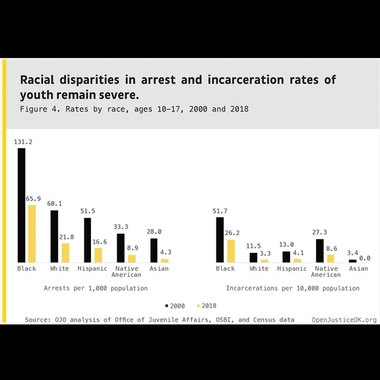All Oklahoma children deserve a fair and equal juvenile justice system

by Ashley Harvey
Op-Ed
Our juvenile justice system is failing youth of color. Today’s youth are committing fewer crimes, and fewer youths are being arrested, but there are still differences in how they are treated based on their race and where they live.
The justice system will continue to be unfair to people of color unless lawmakers take deliberate steps to fix it.
Oklahoma’s juvenile justice system treats people differently based on the color of their skin. Black youths are three times more likely to be arrested and six times more likely to be incarcerated. Native American youth who are arrested are two and a half times more likely to be incarcerated than white youth.
There are also major differences in how often juveniles are arrested between counties. Arrest rates for juveniles are six times higher in Pottawatomie County than in bordering Seminole County. The most staggering discrepancy in arrest rates is for Kay County, which has juvenile arrest rates five times the state average.
We can’t fully comprehend the disparities Oklahomans of color face without acknowledging our state’s history. From forced resettlement of American Indians to the Greenwood race massacre, the effects of our past are still present.
Oklahomans of color generally make less money, have unequal access to quality education and medical care, and are more likely to live in communities that lack resources. Black youth in Oklahoma are nearly six times more likely, and Native American youth are two times as likely to live in concentrated poverty — neighborhoods where 30 percent or more of the population lives in poverty — compared to white youth.
Black students in Oklahoma are more than four times as likely to have a school-related arrest and six times as likely to be expelled compared to white students. While rates school-related arrests for Native American youth are comparable to their white counterparts, the consequences for them are more severe given their likelihood of incarceration once arrested.
One in every 15 Black men in Oklahoma are incarcerated. And although Native Americans make up only nine percent of our population, Native American women account for 12 percent of Oklahoma’s female prison population.
Ripple effects of these disparities traumatize our youth, rip apart families, and devastate communities. Disparities in arrest rates for youth of color are particularly high within rural communities. And just as in the adult system, people working within the juvenile justice system hold a great amount of decision-making power.
Kay County’s staggering juvenile arrest rates, five times the state average, highlight the vast difference between counties. Kay County has been previously highlighted for stark differences in adult felony filings, suggesting an overall punitive approach to justice.
Causes of racial and local disparities within Oklahoma’s juvenile justice system are historical, complex, and cannot be solved overnight. But if we fail to acknowledge our faults and begin to make progress towards solutions, we are failing our children and our state.
When people are treated differently based on their race or geography, we all suffer. The economic and emotional costs of incarceration for families within our state are devastating, even more so for families of color.
Progress cannot be made without data-driven conversations about race. To reduce racial disparity in juvenile justice, all youth-serving agencies need to incorporate a racial equity lens into every aspect of their work. Only then can progress be made towards a system that is truly just for all Oklahomans.
Ashley Harvey is the justice data analyst for Open Justice Oklahoma, a project of Oklahoma Policy Institute. www. okpolicy.org.
The Gayly. 11/11/2019 @ 8:02 a.m. CST.





